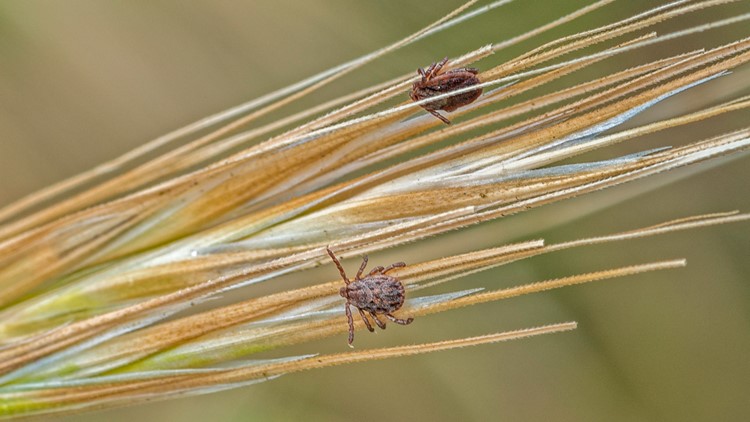MICHIGAN, USA — Most West Michigan counties have a known risk for Lyme disease, a tick-borne illness caused by bacteria.
The beginning of spring means that several of these tick species will no longer be dormant and will start latching themselves on to humans and animals around the state. The tick season usually begins in early spring and lasts through the fall.
There are over 20 known tick species in Michigan, but almost 99% of all of the tick species in Michigan are one of five varieties.
Most common tick species in Michigan and the diseases they carry
The list shows the five most common species of ticks in order from most to least common.
- American dog tick (wood tick)—Known to carry Rocky Mountain spotter fever and tularemia.
- Blacklegged tick (deer tick)—Known to carry Lyme disease, anaplasmosis, babesiosis, deer tick virus and Ehrlichia muris-like disease.
- Lone star tick—Known to carry Ehrlichiosis and tularemia.
- Woodchuck tick—Powassan encephalitis.
- Brown dog tick (kennel tick)—Rocky Mountain spotter fever, canine babesiosis and canine ehrlichiosis.
The Michigan Department of Health and Human Services shared images, descriptions and key facts about the five most common ticks and the diseases they carry.
How to prevent infection from tick-borne diseases
Avoid areas with lots of ticks
- Most tick species prefer shady, moist areas in wooded and grassy locations. Be careful when spending time in these areas during the warmer months of April through September.
- When in areas preferred by ticks, try to stay on paths and avoid contact with tall grass, brush and ground that is covered in fallen leaves.
Check your skin and clothes for ticks
- Wearing light-colored clothes when in areas preferred by ticks allows for ticks to be easily spotted.
- Perform a check for ticks after being outdoors. Be sure to check all parts of your body, including armpits, scalp and groin.
- Showering after being outdoors can wash off ticks and help with finding them.
- Search your clothes for ticks before going indoors.
- Put clothes in a dryer after being outdoors on high heat for at least 10 minutes to kill ticks.
Consider using insect repellents
- Environmental Protection Agency (EPA) approved repellents registered for ticks include products containing:
- DEET
- Picaridin
- Oil of Lemon Eucalyptus
- Permethrin is another type of repellent that can kill ticks. Permethrin should NOT be applied directly to skin, but can be applied to clothing, shoes and outdoor gear. Such products once applied will continue to repel ticks even after several washings.
- Whenever using an insect repellent, always read and follow the label directions for proper application and safety concerns.
Even when actively taking steps to prevent tick bites, there is always a chance that one will attach itself to you when spending time outdoors in warmer months. If a tick does attach itself to you, it is important to know how to remove the tick.
Tick removal
Ticks can attach themselves to any part of the body but prefer the groin, armpit, ankles and scalp.
How to remove an attached tick
- Use a fine-tipped pair of tweezers to grasp the tick closely to the surface of your skin as possible.
- Pull upward with the tweezers with steady even pressure. Do not twist or pull quickly because it can cause the tick's mouth-parts to break off and remain in the skin. Note: If the mouth does break off, remove all of the remaining mouth-parts with a clean set of tweezers that you can.
- After removing the tick, clean the area with rubbing alcohol or soap and water.
The Michigan Department of Health and Human Services released an educational guide on identifying ticks, the diseases they carry and how to prevent tick-borne illness.
For more information on ticks in Michigan, visit the Michigan Department of Health & Human Services tick information page here.
►Make it easy to keep up to date with more stories like this. Download the 13 ON YOUR SIDE app now.
Have a news tip? Email news@13onyourside.com, visit our Facebook page or Twitter. Subscribe to our YouTube channel.



